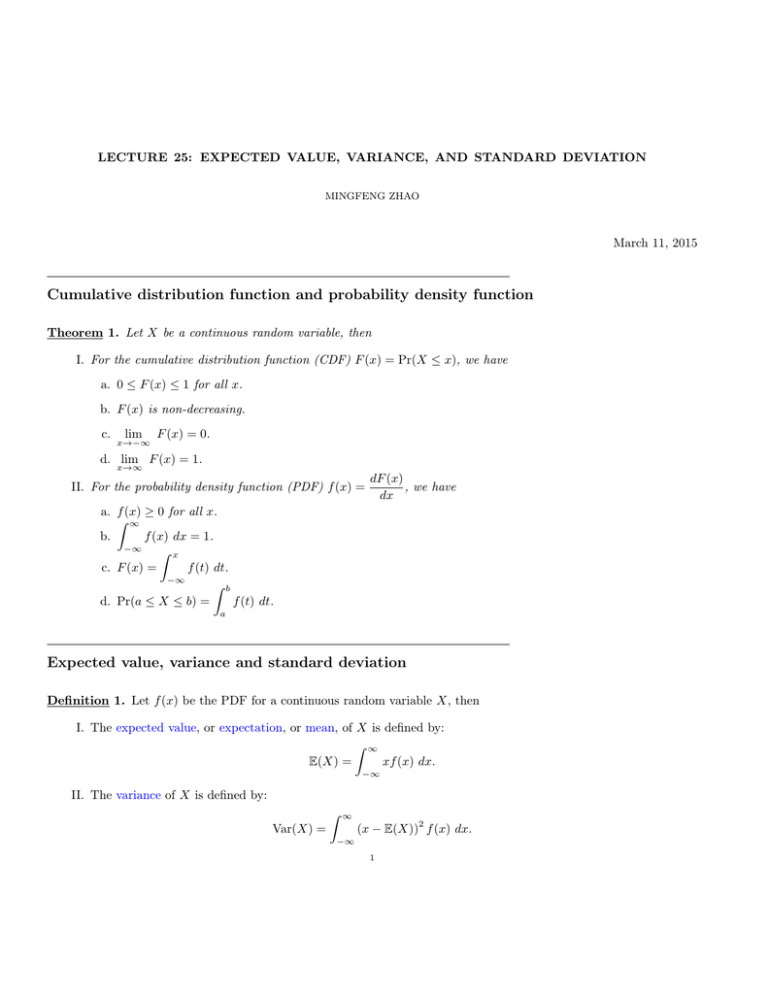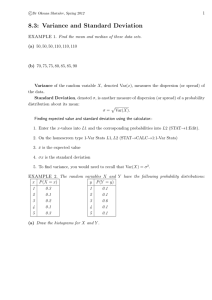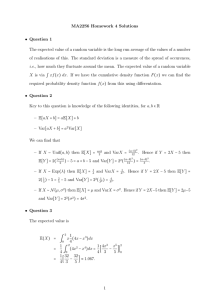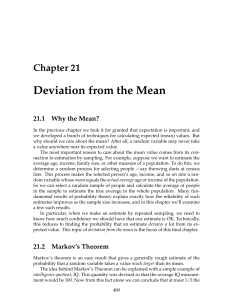Cumulative distribution function and probability density function
advertisement

LECTURE 25: EXPECTED VALUE, VARIANCE, AND STANDARD DEVIATION MINGFENG ZHAO March 11, 2015 Cumulative distribution function and probability density function Theorem 1. Let X be a continuous random variable, then I. For the cumulative distribution function (CDF) F (x) = Pr(X ≤ x), we have a. 0 ≤ F (x) ≤ 1 for all x. b. F (x) is non-decreasing. c. lim x→−∞ F (x) = 0. d. lim F (x) = 1. x→∞ II. For the probability density function (PDF) f (x) = dF (x) , we have dx a. f (x) ≥ 0 for all x. Z ∞ b. f (x) dx = 1. −∞ Z x c. F (x) = f (t) dt. −∞ Z b d. Pr(a ≤ X ≤ b) = f (t) dt. a Expected value, variance and standard deviation Definition 1. Let f (x) be the PDF for a continuous random variable X, then I. The expected value, or expectation, or mean, of X is defined by: Z ∞ E(X) = xf (x) dx. −∞ II. The variance of X is defined by: Z ∞ 2 (x − E(X)) f (x) dx. Var(X) = −∞ 1 2 MINGFENG ZHAO III. The standard deviation of X is defined by: σ(X) = p Var(X). Theorem 2. Let f (x) be a PDF for a continuous random variable X and g(x) be a continuous function, then Z ∞ g(x)f (x) dx. E(g(X)) = −∞ Theorem 3. For Var(X), we also have Var(X) = E(X 2 ) − [E(X)]2 . Proof. By the definition of Var(X), we have Z ∞ 2 Var(X) = (x − E(X)) f (x) dx −∞ ∞ Z = 2 x − 2xE(X) + [E(X)]2 f (x) dx −∞ ∞ Z Z 2 ∞ x f (x) dx − 2E(X) = −∞ 2 Z ∞ xf (x) dx + [E(X)] −∞ = E(X 2 ) − 2E(X) · E(X) + [E(X)]2 = E(X 2 ) − [E(X)]2 . f (x) dx −∞ Example 1. The length of time X, needed by students in a course to complete a 1 hour exam is a random variable X k(x2 + x), if 0 ≤ x ≤ 1, with PDE given by f (x) = , then 0, otherwise. a. Find the value k. b. Find the CDF. c. Find the probability that a randomly selected student will finish the exam in less that half an hour. d. Find the mean time needed to complete in an 1 hour exam. e. Find the variance and standard deviation of X. Solution: a. Since f (x) is a PDF, then Z 1 ∞ = f (x) dx −∞ Z = 0 1 k(x2 + x) dx LECTURE 25: EXPECTED VALUE, VARIANCE, AND STANDARD DEVIATION 1 1 3 1 2 x + x 3 2 0 1 1 = k· + 3 2 = k = 5 k. 6 So 6 . 5 Z x k(x2 + x), if 0 ≤ x ≤ 1, b. For the CDF , we have F (x) = f (t) dt. Since f (x) = , then 0, −∞ otherwise. k= • For x ≤ 0, we have Z x x Z F (x) = f (t) dt = 0 dt = 0. −∞ −∞ • For x ≥ 1, we have x Z F (x) = f (t) dt −∞ 0 Z Z = 1 f (t) dt + −∞ Z = 0 dt + −∞ x f (t) dt + 0 0 Z Z f (t) dt 1 1 Z f (t) dt + 0 x 0 dt 1 1 Z = f (t) dt 0 = 1 By the computation in part a. • For any 0 ≤ x ≤ 1, we have Z F (x) x = f (t) dt −∞ Z 0 = Z f (t) dt + −∞ Z = = Z 0 dt + −∞ f (t) dt 0 0 = x 0 x 6 2 (t + t) dt 5 x 6 1 3 1 2 t + t 5 3 2 0 6 1 3 1 2 x + x . 5 3 2 3 4 MINGFENG ZHAO In summary, we have 0, if x ≤ 0, 6 1 1 F (x) = x3 + x2 , if 0 ≤ x ≤ 1, 5 3 2 1, if x ≥ 1. c. By the result of part b, we have " 2 # 3 1 1 6 1 1 1 1 6 1 1 6 4 1 Pr X < =F = · · + · = · + = · = . 2 2 5 3 2 2 2 5 24 8 5 24 5 d. In fact, we have ∞ Z E(X) = xf (x) dx −∞ 1 Z 6 x · (x2 + x) dx 5 = 0 = = = = = 1 Z 6 5 (x3 + x2 ) dx 0 1 6 1 4 1 3 x + x 5 4 3 0 6 1 1 · + 5 4 3 6 7 · 5 12 7 . 10 e. In fact, we have 2 E(X ) ∞ Z x2 f (x) dx = −∞ 1 Z 6 x2 · (x2 + x) dx 5 = 0 = = = = = 6 5 Z 1 (x4 + x3 ) dx 0 1 6 1 5 1 4 x + x 5 5 4 0 6 1 1 · + 5 5 4 6 9 · 5 20 54 100 LECTURE 25: EXPECTED VALUE, VARIANCE, AND STANDARD DEVIATION 5 = E(X 2 ) − [E(X)]2 2 54 7 = − 100 10 Var(X) 54 49 − 100 100 5 = 100 1 = 20 p σ(X) = Var(X) r 1 = 20 1 √ = 2 5 √ 5 = . 10 2(1 − x), if 0 ≤ x ≤ 1, Example 2. A random variable X is given by the PDF f (x) = , compute the cumulative 0, otherwise. distribution function, the expected value, variance, and standard deviation. Z x For the CDF, we have F (x) = f (t) dt, then = −∞ • If x ≤ 0, then Z x Z F (x) = x f (t) dt = 0 dt = 0. −∞ −∞ • If 0 ≤ x ≤ 1, then Z x F (x) = Z f (t) dt = −∞ 0 x x 2(1 − t) dt = (2t − t2 )0 = 2x − x2 . • If x ≥ 1, then Z x 1 Z F (x) = 2(1 − t) dt = 1. f (t) dt = −∞ 0 In summary, we get 0, F (x) = 2x − x2 , 1, Notice that Z E(X) ∞ = xf (x) dx −∞ if x ≤ 0, if 0 < x < 1, if x ≥ 1. 6 MINGFENG ZHAO 1 Z x · 2(1 − x) = 0 1 Z [2x − 2x2 ] dx = 0 = 1 2 3 2 x − x 3 0 = 1− = E(X 2 ) 1 3 Z 2 3 ∞ x2 f (x) dx = −∞ 1 Z x2 · 2(1 − x) dx = 0 1 Z 2 2x − 2x3 dx = 0 = = = Var(X) = = = = σ(X) = = = = 1 2 3 2 4 x − x 3 4 0 2 1 − 3 2 1 6 E(X 2 ) − [E(X)]2 2 1 1 − 6 3 By Theorem 3 1 1 − 6 9 1 18 p Var(X) r 1 18 1 √ 3 2 √ 2 . 6 Department of Mathematics, The University of British Columbia, Room 121, 1984 Mathematics Road, Vancouver, B.C. Canada V6T 1Z2 E-mail address: mingfeng@math.ubc.ca







